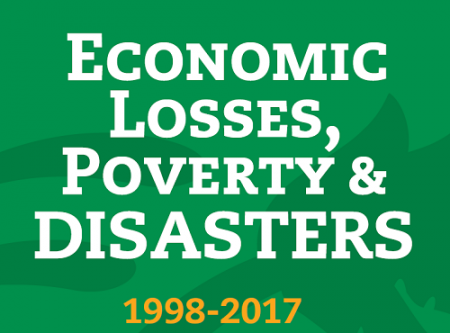
GENEVA, 10 October 2018 – The last twenty years have seen a dramatic rise of 251% in direct economic losses from climate-related disasters, according to a report released today by the UN Office for Disaster Risk Reduction in advance of International Day for Disaster Reduction on October 13.
In the period 1998-2017, disaster-hit countries reported direct economic losses of US$2,908 billion of which climate-related disasters accounted for US$2,245 billion or 77% of the total.
This compares with total reported losses for the period 1978-1997 of US$1,313 billion of which climate-related disasters accounted for US$895 billion or 68%.
In terms of occurrences, climate-related disasters also dominate the picture, accounting for 91% of all 7,255 major recorded events between 1998 and 2017. Floods, 43.4%, and storms, 28.2%, are the two most frequently occurring disasters.
The greatest economic losses have been experienced by the USA, US$ 944.8 billion; China, US$492.2 billion; Japan, US$376.3 billion; India, US$ 79.5 billion; and Puerto Rico, US$ 71.7 billion. Storms, floods and earthquakes place three European countries in the top ten for economic losses: France, US$48.3 billion; Germany, US57.9 billion; and Italy, US$56.6 billion. Thailand, US$ 52.4 billion, and Mexico, US$ 46.5 billion, complete the list.
During this period, 1.3 million people lost their lives and 4.4 billion people were injured, rendered homeless, displaced or in need of emergency assistance. 563 earthquakes, including related tsunamis, accounted for 56% of total deaths or 747,234 lives lost.
The report “Economic Losses, Poverty and Disasters 1998-2017” drills down into the Emergency Events Database (EM-DAT) maintained by the Centre for Research on the Epidemiology of Disasters (CRED) at the Catholic University of Louvain, Belgium.
A key target of the global plan to reduce disaster losses, the Sendai Framework for Disaster Risk Reduction, is to reduce economic losses from disasters and the report highlights the fact that 63% of disaster reports contain no economic data.
Another key highlight is the disproportionate impact of disaster events on low and middle-income countries even if high-income countries bear the brunt of absolute economic losses.
Only one high-income territory ranked among the “top ten” in terms of annual average percentage losses relative to GDP, Puerto Rico, 12.2%. Moving across the globe, the others are Haiti, 17.5%; Honduras, 7%; Cuba, 4.6%; El Salvador, 4.2%; Nicaragua, 3.6%; Georgia, 3.5%; Mongolia, 2.8%; Tajikistan, 2.7%; and DPR Korea, 7.4%.
The UN Secretary-General’s Special Representative for Disaster Reduction, Mami Mizutori, said: “This report highlights key trends over the last 40 years. Much needs to be done to address the high number of deaths in seismic zones. The death and suffering caused by this month’s earthquake and tsunami in Indonesia brings home the need to raise public awareness and to apply high standards for construction in seismic zones.